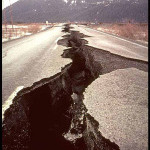Created by: Silentchapel
Number of Blossarys: 95
A foreshock is an earthquake that occurs before a larger seismic event (the mainshock) and is related to it in both time and space. The designation of an earthquake as foreshock, mainshock or ...
An aftershock is a smaller earthquake that occurs after a previous large earthquake, in the same area of the main shock. If an aftershock is larger than the main shock, the aftershock is redesignated ...
A tsunami earthquake is an earthquake that triggers a tsunami of a magnitude that is very much larger than the magnitude of the earthquake as measured by shorter-period seismic waves. The term was ...
A slow earthquake is a discontinuous, earthquake-like event that releases energy over a period of hours to months, rather than the seconds to minutes characteristic of a typical earthquake. First ...
In seismology, the depth of focus refers to the depth at which an earthquake occurs. Earthquakes occurring at a depth of less than 70 km are classified as 'shallow-focus' earthquakes, while ...
An intraplate earthquake is an earthquake that occurs in the interior of a tectonic plate, whereas an interplate earthquake is one that occurs at a plate boundary. Intraplate earthquakes are ...
The San Andreas Fault is a continental transform fault that extends roughly 810 miles (1,300 km) through California in the United States. It forms the tectonic boundary between the Pacific Plate and ...


 English (EN)
English (EN)





